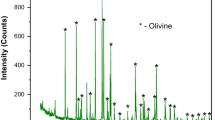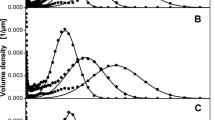Abstract
This work aims to provide a relationship of how the key operational variables of frother type and impeller speed affect the size of bubble (D 32). The study was performed using pilot-scale equipment (0.8 m3) that is up to two orders of magnitude larger than equipment used for studies performed to date by others, and incorporated the key process variables of frother type and impeller speed. The results show that each frother family exhibits a unique CCC95-HLB relationship dependent on n (number of C-atoms in alkyl group) and m (number of propylene oxide group). Empirical models were developed to predict CCC95 from HLB associated with other two parameters α and β. The impeller speed-bubble size tests show that D 32 is unaffected by increased impeller tip speed across the range of 4.6 to 9.2 m/s (representing the industrial operating range), although D 32 starts to increase below 4.6 m/s. The finding is valid for both coalescing and non-coalescing conditions. The results suggest that the bubble size and bubble size distribution (BSD) being created do not change with increasing impeller speed in the quiescent zone of the flotation.
Similar content being viewed by others
References
GRAU R A, HEISKANEN K. Bubble size distribution in laboratory scale flotation cells [J]. Minerals Engineering, 2005, 18: 1164–1172.
ZHANG Wei, NESSET J E, Finch J A. Water recovery and bubble surface area flux in flotation [J]. Canadian Metallurgical Quarterly, 2010, 49(4): 353–362.
KRACHT W, FINCH J A. Bubble break-up and the role of frother and salt [J]. International Journal of Mineral Processing, 2009, 92(3/4): 153–161.
REAY D, RATCLIFF G A. Removal of fine particles from water by dispersed air flotation: Effects of bubble size and particle size on collection efficiency [J]. Canadian Journal of Chemical Engineering 1975, 53(10): 178–185.
ANFRUNS J P, KITCHENER J A. Flotation machines [M]. New York: SME of AIME, 1976: 625–637.
JAMESON G J. New directions in flotation machine design [J]. Minerals Engineering, 2010, 23(11/12/13): 835–841.
HARBORT G, SCHWARZ S. Characterisation measurements in industrial flotation cells [C]// Flotation Plant Optimisation: A Metallurgical Guide to Identifying and Solving Problems in Flotation Plants. Carlton, Australia: AusIMM Publications, 2010: 95–106.
NESSET J E, FINCH J A, GOMEZ C O. Operating variables affecting the bubble size in forced-air mechanical flotation machines [C]// Proceedings of Ninth Mill Operators’ Conference. Fremantle, Australia: 2007: 19–21.
PUGH R J. The physics and chemistry of frothers [C]// Eds. Fuerstenau, M C, Jameson, G. and Yoon, R H, Froth Flotation: A Century of Innovation. New York: SME Publications, 2007: 259–281.
ZHANG Wei, ZHOU X, FINCH J A. Determining independent control of dual-frother systems-gas holdup, bubble size and water overflow rate [J]. Minerals Engineering, 2012, 39: 106–116.
ZHANG Wei, ZHU S, FINCH J A. Frother partitioning in dual-frother systems: Development of analytical technique [J]. International Journal of Mineral Processing, 2013, 119(75/76/77/78/79/80/81/82): 75–82.
CAPPUCCITTI F, FINCH J A. Development of new frothers through hydrodynamic characterization [J]. Minerals Engineering, 2008, 21(12/13/14): 944–948.
CAPPUCCITTI F, NESSET J E, FINCH J A. Frother and collector effects on flotation cell hydrodynamics and their implication on circuit performance [C]// Proceedings of the 48th Annual Conference of Metallurgists of CIM, Advances in Mineral Processing Science and Technology (Section). Sudbury, Canada: MetSoc CIM, 2009: 169–180.
HU Yue-hua, MENG Xiang-li, SUN Wei. A novel quantificational assessment method of frothers effect on bubble characteristics [J]. Journal of Central South University of Technology, 2011, 18: 1910–1916.
DAVIES J T, RIDEAL E K. Interfacial phenomena [M]. New York: Academic Press, 1961: 46–47.
LASKOWSKI J S. Fundamental properties of flotation frothers [C]// Proceeding of the 22nd International Mineral Processing Congress (IMPC). Cape Town, South Africa, 2003: 788–797.
NESSET J E. Modeling the Sauther mean bubble diameter in mechanical, forced-air flotation machines [D]. Montreal, Canada: McGill University, 2011.
NESSET J E, ZHANG Wei, FINCH J A. A benchmarking tool for assessing flotation cell performance [C]// Proceedings of 44th Annual Meeting of the Canadian Mineral Processors (CIM). Ottawa, Canada, 2012: 183–209.
ZHANG Wei, NESSET J E, RAO S R, FINCH J A. Characterizing frothers through critical coalescence concentration (CCC95)-hydrophilic-lipophilic balance (HLB) [J]. Minerals, 2012, 2(3): 208–227.
GORAIN B K, FRANZIDIS J P, MANLAPIG E V. The empirical prediction of bubble surface area flux in mechanical flotation cells [J]. Minerals Engineering, 1999, 12(3): 309–322.
DEGLON D A, EGYA-MENSAH D, FRANZIDIS J P. Review of hydrodynamics and gas dispersion in flotation cells on South African platinum concentrators [J]. Minerals Engineering, 2000, 13(3): 235–244.
ZHANG Wei, KOLAHDOOZAN M, NESSET J E, FINCH J A. Use of frother with sampling-for-imaging bubble Sizing Technique [J]. Minerals Engineering, 2009, 22(5): 513–515.
KEITEL G, ONKEN U. Inhibition of bubble coalescence by solutes in air/water dispersions [J]. Chemical Engineering Science, 1982, 37(11): 1635–1638.
DROGARIS G, WEILAND P. Coalescence behaviour of gas bubbles in aqueous solutions of n-alcohols and fatty acids [J]. Chemical Engineering Science, 1983, 38(9): 1501–1506.
GRONSTRAND S, NIITTI T. Flotation enters its second century with higher intensity and bigger capacity [C]// Proceedings of Mineral Processing Conference. Luleå, Sweden: Mineral Teknik, 2007: 1–13.
Author information
Authors and Affiliations
Corresponding author
Additional information
Foundation item: Project supported by the Collaborative Research and Development Program of NSERC (Natural Sciences and Engineering Research Council of Canada) with Industrial Sponsorship from Vale, Teck Cominco, Xstrata Process Support, Agnico-Eagle, Shell Canada, Barrick Gold, COREM, SGS Lakefield Research and Flottec
Rights and permissions
About this article
Cite this article
Zhang, W., Nesset, J.E. & Finch, J.A. Effect of some operational variables on bubble size in a pilot-scale mechanical flotation machine. J. Cent. South Univ. 21, 1077–1084 (2014). https://doi.org/10.1007/s11771-014-2039-8
Received:
Accepted:
Published:
Issue Date:
DOI: https://doi.org/10.1007/s11771-014-2039-8




